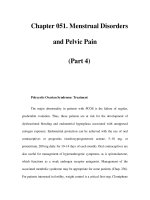Chapter 090. Bladder and Renal Cell Carcinomas (Part 4) potx
Bạn đang xem bản rút gọn của tài liệu. Xem và tải ngay bản đầy đủ của tài liệu tại đây (11.67 KB, 5 trang )
Chapter 090. Bladder and Renal
Cell Carcinomas
(Part 4)
Metastatic Disease
The primary goal of treatment for metastatic disease is to achieve complete
remission with chemotherapy alone or with a combined-modality approach of
chemotherapy followed by surgical resection of residual disease, as is done
routinely for the treatment of germ cell tumors. One can define a goal in terms of
cure or palliation on the basis of the probability of achieving a complete response
to chemotherapy using prognostic factors, such as Karnofsky Performance Status
(KPS) (<80%), and whether the pattern of spread is nodal or visceral (liver, lung,
or bone). For those with zero, one, or two risk factors, the probability of complete
remission is 38, 25, and 5%, respectively, and median survival is 33, 13.4, and 9.3
months, respectively. Patients who are functionally compromised or who have
visceral disease or bone metastases rarely achieve long-term survival. The
toxicities also vary as a function of risk, and treatment-related mortality rates are
as high as 3–4% using some combinations in these poor-risk patient groups.
Chemotherapy
A number of chemotherapeutic drugs have shown activity as single agents;
cisplatin, paclitaxel, and gemcitabine are considered most active. Standard therapy
consists of two-, three-, or four-drug combinations. Overall response rates of
>50% have been reported using combinations such as methotrexate, vinblastine,
doxorubicin, and cisplatin (M-VAC); cisplatin and paclitaxel (PT); gemcitabine
and cisplatin (GC); or gemcitabine, paclitaxel, and cisplatin (GTC). M-VAC was
considered standard, but the toxicities of neutropenia and fever, mucositis,
diminished renal and auditory function, and peripheral neuropathy led to the
development of alternative regimens. At present, GC is used more commonly than
M-VAC, based on the results of a comparative trial of M-VAC versus GC that
showed less neutropenia and fever, and less mucositis for the GC regimen.
Anemia and thrombocytopenia were more common with GC. GTC is not more
effective than GC.
Chemotherapy has also been evaluated in the neoadjuvant and adjuvant
settings. In a randomized trial, patients receiving three cycles of neoadjuvant M-
VAC followed by cystectomy had a significantly better median (6.2 years) and 5-
year survival (57%) compared to cystectomy alone (median survival 3.8 years; 5-
year survival 42%). Similar results were obtained in an international study of three
cycles of cisplatin, methotrexate, and vinblastine (CMV) followed by either
radical cystectomy or radiation therapy. The decision to administer adjuvant
therapy is based on the risk of recurrence after cystectomy. Indications for
adjuvant chemotherapy include the presence of nodal disease, extravesical tumor
extension, or vascular invasion in the resected specimen. Another study of
adjuvant therapy found that four cycles of CMV delayed recurrence, although an
effect on survival was less clear. Additional trials are studying taxane- and
gemcitabine-based combinations.
The management of bladder cancer is summarized in Table 90-2.
Table 90-2 Management of Bladder Cancer
Nature of
Lesion
Management Approach
Superficial
Endoscopic removal, usually with intravesical
therapy
Invasive
Cystectomy ± systemic chemotherapy (before or
disease after surgery)
Metastatic
disease
Curative or palliative chemotherapy (based on
prognostic factors) ± surgery
Carcinoma of the Renal Pelvis and Ureter
About 2500 cases of renal pelvis and ureter cancer occur each year; nearly
all are transitional cell carcinomas similar to bladder cancer in biology and
appearance. This tumor is also associated with chronic phenacetin abuse and with
Balkan nephropathy, a chronic interstitial nephritis endemic in Bulgaria, Greece,
Bosnia-Herzegovina, and Romania.
The most common symptom is painless gross hematuria, and the disease is
usually detected on intravenous pyelogram during the workup for hematuria.
Patterns of spread are like those in bladder cancer. For low-grade disease localized
to the renal pelvis and ureter, nephroureterectomy (including excision of the distal
ureter with a portion of the bladder) is associated with 5-year survival of 80–90%.
More invasive or histologically poorly differentiated tumors are more likely to
recur locally and to metastasize. Metastatic disease is treated with the
chemotherapy used in bladder cancer, and the outcome is similar to that of
metastatic transitional cell cancer of bladder origin.









